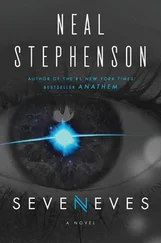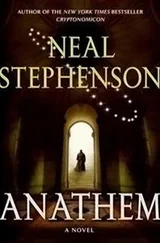The pipes sprouted in parallel ranks from a broad flat box of compressed air. All of the pipes for a given note—but belonging to different stops—lined up with each other along one axis. All of the pipes for a given stop—but tuned at different pitches—lined up with each other along the other, perpendicular axis. Down there in the flat box of air, then, was a mechanism that got air to the right pipes at the right times. When a key or pedal was depressed, all of the pipes capable of sounding the corresponding note would speak, as long as their stops were pulled out.
Mechanically, all of this was handled in a fashion that was perfectly clear, simple, and logical. Lawrence had supposed that the machine must be at least as complicated as the most intricate fugue that could be played on it. Now he had learned that a machine, simple in its design, could produce results of infinite complexity.
Stops were rarely used alone. They tended to be piled on top of each other in combinations that were designed to take advantage of the available harmonics (more tasty mathematics here!). Certain combinations in particular were used over and over again. Lots of blockflötes, in varying lengths, for the quiet Offertory, for example. The organ included an ingenious mechanism called the preset, which enabled the organist to select a particular combination of stops—stops he himself had chosen—instantly. He would punch a button and several stops would bolt out from the console, driven by pneumatic pressure, and in that instant the organ would become a different instrument with entirely new timbres.
The next summer both Lawrence and Alice, his mother, were colonized by a distant cousin—a stupendous badass of a virus. Lawrence escaped from it with an almost imperceptible tendency to drag one of his feet. Alice wound up in an iron lung. Later, unable to cough effectively, she got pneumonia and died.
Lawrence's father, Godfrey, freely confessed that he was not equal to the burdens now laid on his shoulders. He resigned from his position at the small college in Virginia and moved, with his son, to a small house in Moorhead, Minnesota, next door to where Bunyan and Blanche had settled. Later he got a job teaching at a nearby normal school.
At this point, all of the responsible adults in Lawrence's life seemed to arrive at a tacit agreement that the best way to raise him—certainly the easiest—was to leave him alone. On the rare occasions when Lawrence requested adult intervention in his life, he was usually asking questions that no one could answer. At the age of sixteen, having found nothing in the local school system to challenge him, Lawrence Pritchard Waterhouse went off to college. He matriculated at Iowa State College, which among other things was the site of a Naval ROTC installation in which he was forcibly enrolled.
The Iowa State Naval ROTC had a band, and was delighted to hear that Lawrence had an interest in music. Since it was hard to drill on the deck of a dreadnought while playing a pipe organ, they issued him a glockenspiel and a couple of little dingers.
When not marching back and forth on the flood plain of the Skunk River making loud dinging noises, Lawrence was majoring in mechanical engineering. He ended up doing poorly in this area because he had fallen in with a Bulgarian professor named John Vincent Atanasoff and his graduate student, Clifford Berry, who were building a machine that was intended to automate the solution of some especially tedious differential equations.
The basic problem for Lawrence was that he was lazy. He had figured out that everything was much simpler if, like Superman with his X-ray vision, you just stared through the cosmetic distractions and saw the underlying mathematical skeleton. Once you found the math in a thing, you knew everything about it, and you could manipulate it to your heart's content with nothing more than a pencil and a napkin. He saw it in the curve of the silver bars on his glockenspiel, saw it in the catenary arch of a bridge and in the capacitor-studded drum of Atanasoff and Berry's computing machine. Actually pounding on the glockenspiel, riveting the bridge together, or trying to figure out why the computing machine wasn't working were not as interesting to him.
Consequently he got poor grades. From time to time, though, he would perform some stunt on the blackboard that would leave his professor weak in the knees and the other students baffled and hostile. Word got around.
At the same time, his grandmother Blanche was invoking her extensive Congregational connections, working the angles on Lawrence's behalf, totally unbeknownst to him. Her efforts culminated in triumph when Lawrence was awarded an obscure scholarship, endowed by a St. Paul oat-processing heir, whose purpose was to send Midwestern Congregationalists to the Ivy League for one year, which (evidently) was deemed a long enough period of time to raise their IQs by a few crucial points but not long enough to debauch them. So Lawrence got to be a sophomore in Princeton.
Now Princeton was an august school and going there was a great honor, but no one got around to mentioning either of these facts to Lawrence, who had no way of knowing. This had bad and good consequences. He accepted the scholarship with a faintness of gratitude that infuriated the oat lord. On the other hand, he adjusted to Princeton easily because it was just another place . It reminded him of the nicer bits of Virginia, and there were some nice pipe organs in town, though he was not all that happy with his engineering homework of bridge-designing and sprocket-cutting problems. As always, these eventually came down to math, most of which he could handle easily. From time to time he would get stuck, though, which led him to the Fine Hall: the headquarters of the Math Department.
There was a motley assortment of fellows wandering around in Fine Hall, many sporting British or European accents. Administratively speaking, many of these fellows were not members of the Math Department at all, but a separate thing called IAS, which stood for Institute for Advanced something-or-other. But they were all in the same building and they all knew a thing or two about math, so the distinction didn't exist for Lawrence.
Quite a few of these men would pretend shyness when Lawrence sought their advice, but others were at least willing to hear him out. For example: he had come up with a way to solve a difficult sprocket tooth shape problem that, as normally solved by engineers, would require any number of perfectly reasonable but aesthetically displeasing approximations. Lawrence's solution would provide exact results. The only draw back was that it would require a quintillion slide-rule operators a quintillion years to solve. Lawrence was working on a radically different approach that, if it worked, would bring those figures down to a trillion and a trillion respectively. Unfortunately, Lawrence was unable to interest anyone at Fine Hall in anything as prosaic as gears, until all of a sudden he made friends with an energetic British fellow, whose name he promptly forgot, but who had been doing a lot of literal sprocket-making himself lately. This fellow was trying to build, of all things, a mechanical calculating machine—specifically a machine to calculate certain values of the Riemann Zeta Function

where s is a complex number.
Lawrence found this zeta function to be no more and no less interesting than any other math problem until his new friend assured him that it was frightfully important, and that some of the best mathematicians in the world had been gnawing on it for decades. The two of them ended up staying awake until three in the morning working out the solution to Lawrence's sprocket problem. Lawrence presented the results proudly to his engineering professor, who snidely rejected it, on grounds of practicality, and gave him a poor grade for his troubles.
Читать дальше






